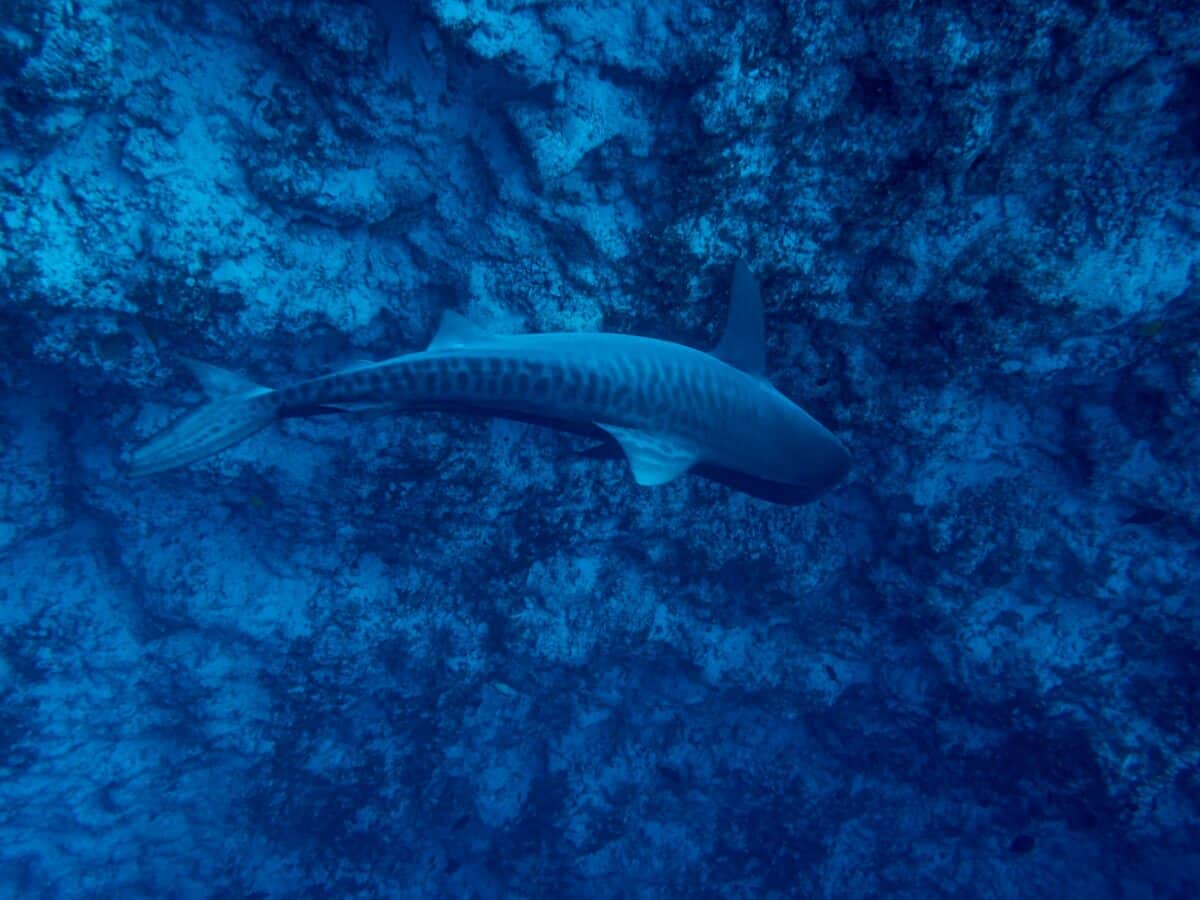In this post we will be comparing two powerful predators of our oceans: the Great White Shark Vs. Tiger Shark.
We will be exploring two wonders of the ocean and take a look into the magnificent predators of the marine world. Two of the most iconic predators under the water’s surface are the White Shark and the Tiger Shark. These majestic creatures are often portrayed as fierce competitors in popular culture, but how do they compare?
In this comprehensive assessment, we will delve into the world of these two sharks, exploring their physical characteristics, habitats, behaviors, and diets to gain a deeper understanding of what sets them apart and brings them together. Whether you are a shark enthusiast, a marine biologist, or simply curious about these amazing animals, this guide will provide you with a wealth of information.
Are you ready for some incredible insights about these ferocious predators? Let’s take a look at the Great White Shark Vs. Tiger Shark.
Jump ahead to the section of your choice below:
Physical Characteristics: Great White Shark Vs. Tiger Shark

Both species are two terrifying ocean predators. Although sharing some traits, their physical attributes unveil unique distinctions between them.
Size and Weight Differences
Great White Sharks are larger than Tiger Sharks; Great White Sharks can grow quite large, with adult specimens capable of reaching lengths of up to 20 feet and weighing a massive 2,500 pounds. Male Great White Sharks are typically larger than females. They have a distinctive conical snout with up to 3 inches long serrated teeth.
While Tiger Sharks usually grow up to 18 feet long and weigh 1,500 pounds.
Color and Skin Patterns
Great White Sharks have a classic shark appearance, with a grayish upper body and a white underbelly. They also have a distinctive pointed snout and a dorsal fin set far back on their body.
Tiger Sharks have a unique appearance with a dark blue-gray upper body and a lighter underbelly. They also have distinctive vertical stripes that run along their body that almost resemble those of a tiger, which has granted them their name.
Teeth Structure and Size
Great White Sharks and Tiger Sharks have rows of sharp, triangular teeth. However, the structure and size of the teeth vary between the two predator species.
Great White Sharks have teeth that are serrated and triangular with a pointed tip, which allows them to rip through their prey easily. They can have up to 300 teeth at any given time.
Tiger Sharks have teeth that are less pointed and more curved, with a blade-like edge designed to crush the shells of turtles and other hard-shelled prey. They can have up to 24 teeth in each row, with two rows of teeth.
Diet

Great White Sharks are apex predators and feed primarily on seals and sea lions. They use their powerful jaws to bite their prey and then shake their heads to tear off chunks of flesh.
Tiger Sharks, the ultimate opportunistic feeders, are known to consume sea turtles, birds and even garbage. They use their saw-like teeth to crush hard-shelled prey such as crabs and sea turtles.
Habitat and Distribution: Great White Shark Vs. Tiger Shark
When it comes to their habitat, they differ in several aspects. These include their range, migration patterns, preferred habitats, depths, and environmental factors that affect their distribution.
Range and Migration Patterns
Great White Sharks are globally distributed in all major oceans, migrating long distances of up to 12,000 miles annually between warm and cold waters.
In contrast, Tiger Sharks are only found in tropical and subtropical waters. They migrate a much shorter distance of a few hundred miles and move to shallower waters during summer. Some Tiger Shark populations migrate towards the poles during winter.
Preferred Habitats and Depths
Great White Sharks inhabit many habitats, from shallow coastal waters to the open ocean, preferring deeper waters and diving to depths of over 3,000 feet.
Tiger Sharks prefer warmer waters and are often found in shallow coastal areas, estuaries, and coral reefs. It also inhabits deeper waters but not to the same extent as Great White Sharks.
Environmental Factors Affecting Their Distribution
Environmental factors such as water temperature, salinity, and food availability affect the distribution of Great White Sharks and Tiger Sharks.
Great White Sharks prefer cooler waters, while Tiger Sharks are found in warmer waters. Climate change-induced changes in ocean temperatures, currents, and prey availability could significantly impact their distribution.
Behavior and Intelligence

The Great White Shark and Tiger Shark are two of the most well-known species of sharks, and they have distinct differences in their behavior and intelligence.
Behavior
Great White Sharks are aggressive and territorial solitary hunters that migrate long distances for food. They breach the water and circle their prey before attacking. The Great White Sharks are highly intelligent and curious, with some individuals displaying social behavior such as traveling in groups.
Tiger Sharks are scavengers and opportunistic feeders that can eat anything, including garbage. They are more social and less likely to attack humans than Great White Sharks but can be aggressive if provoked. Tiger Sharks are less well-studied than Great White Sharks, but they are known to be highly adaptable and thrive in various habitats.
Intelligence
Sharks are not mindless killing machines. Rather, Great White Sharks and Tiger Sharks are highly intelligent creatures. For example, Great White Sharks navigate using the Earth’s magnetic field and exhibit complex social behaviors.
Tiger Sharks use tools and have great learning and memory abilities. Both species have been observed working together to catch prey and protect injured members of their group.
Understanding the behavior and intelligence of these fascinating creatures can help us better appreciate and protect them in their natural habitats.
Conservation Status
Great white and tiger sharks are apex predators that play important roles in their respective ecosystems.
The IUCN has classified both species as vulnerable, indicating that they are at a high risk of extinction in their natural habitats. Great white sharks face overfishing, habitat loss, and shark finning threats. Tiger sharks also face these threats, and it should be underlined that all of them are induced by humans and human activities.
Conservation efforts such as fishing quotas, marine protected areas, and reducing pollution can help protect these species and their habitats.
Key Points
| Great White Sharks are larger than Tiger Sharks. Great White Sharks can grow quite large, with adult specimens capable of reaching lengths of up to 20 feet and weighing a massive 2,500 pounds. |
| Tiger Sharks usually grow up to 18 feet long and weigh 1,500 pounds. |
| Great White Sharks are aggressive and territorial solitary hunters that migrate long distances for food. Tiger Sharks are scavengers and opportunistic feeders that can eat anything, including garbage. |
| Conservation efforts such as fishing quotas, marine protected areas, and reducing pollution can help protect these species and their habitats. |
| Great white and tiger sharks are apex predators that play important roles in their respective ecosystems. |
Conclusion
Understanding the differences between Great White Sharks and Tiger Sharks is essential for anyone interested in the ocean and marine life. While both sharks are formidable predators with unique adaptations, they have distinct physical and behavioral characteristics that set them apart.
Following the guidelines outlined in this comprehensive guide, individuals can safely observe and appreciate these magnificent creatures while respecting their power and role in the ecosystem. Whether you encounter a Great White Shark or a Tiger Shark in the wild or admire them from afar, it is important to remember that these apex predators are a vital part of the ocean’s biodiversity and should be protected and conserved for future generations to enjoy.
Thank you for reading this piece on the Great White Shark Vs. Tiger Shark! If you want to explore other animals living under the water’s surface, head over to read our post on Beluga Whales.
- The Most Adorable Footage of Baby Wolves in Minnesota - April 15, 2024
- Man Teaches Bald Eagle to Play Fetch - April 15, 2024
- Mother Buffalo Tries to Save Baby From Komodo Dragons - April 14, 2024


